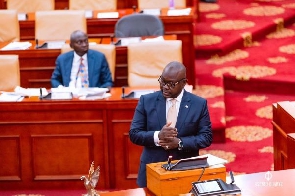 Minister of Works and Housing, Francis Asenso-Boakye
Minister of Works and Housing, Francis Asenso-Boakye
Minister of Works and Housing, Francis Asenso-Boakye, has blamed the latest floods in Ghana on human reasons.
According to the minister, while the government was putting in place measures to manage flooding, human actions such as filling wetlands and lagoons and dumping solid waste in drains made it difficult.
He informed lawmakers that while the government has set aside GH450 million for drain building and desilting since 2018, human factors have hampered the government’s efforts.
“It has become more evident that human activities are severely impeding the government’s efforts to tackle flooding. The observation includes blocking of lagoons and wetlands with construction materials for development purposes, building on drainage channels and blocking the free flow of stormwater, dumping of solid waste in drains thereby reducing their capacity to hold stormwater and the gap in the enforcement of planning and building laws by the various MMDAs,” Mr Asenso-Boakye bemoaned while providing a brief to Parliament on measures by the government to contain the situation.
“Cabinet noted the need to consider flooding in Accra as a national security issue since effective law enforcement has a role to play in resolving the issue. Subsequently, the Cabinet constituted a committee to develop a comprehensive plan with appropriate measures to strengthen the enforcement of laws relating to lands and siting of buildings
“While the Committee does its work, my Ministry will continue its engagement with the National Security Ministry in seeking support for the Assemblies to enforce planning laws and building regulations.”
Providing an update on the progress of projects aimed at mitigating the effects of flooding in Accra he said “Since 2018, the government has committed more than GH¢400 million to address flooding under a special progaramme. Under this programme, 384 desilting projects and 202 channel projects were initiated.
“Today, 370 desilting projects representing 96 percent have been completed and 84 drainage channel projects have been completed, with the remaining 118 at various stages of completion and the effects have been the mitigation of flood hazards in beneficiary communities.”